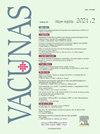Las nuevas vacunas genéticamente atenuadas frente al virus de la poliomielitis
Q3 Medicine
引用次数: 0
Abstract
There are two types of vaccines available against polio virus: the inactivated (Salk, IPV) and the oral/attenuated (Sabin, OPV). Live vaccines are highly effective in inducing protective immunity against certain infections, also favoring the cessation of their epidemic spread. There are three wild serotypes of the polio virus, however currently two of them, serotype 2 and 3, are considered eradicated so that the only one that still circulates in endemic countries is serotype 1. One of the problems of OPV, which cannot occur with IPV, is its possible reversion to the wild form, circulating as vaccinal poliovirus (cOPV) and its transmission to unvaccinated people, giving rise to paralytic processes associated with the vaccine. To avoid this phenomenon, new oral polio vaccines (nOPV-c1) with greater safety and less reversion have been developed by modifying and introducing a series of genetic modifications in the RNA of the virus. Different studies have shown that children who received OPV2-c1 presented a higher degree of attenuation and thermostability and a highly significant decrease in the ability to affect the nervous system and develop severe neurovirulence and possible post-vaccination polio. These studies establish the pathogenic and molecular bases in the most vulnerable child population that allowed the use of this new genetically attenuated vaccine in population vaccination campaigns.
针对脊髓灰质炎病毒的新型基因减毒疫苗
现有两种脊髓灰质炎病毒疫苗:灭活疫苗(Salk, IPV)和口服/减毒疫苗(Sabin, OPV)。活疫苗在诱导对某些感染的保护性免疫方面非常有效,也有利于停止其流行传播。脊髓灰质炎病毒有三种野生血清型,但目前认为其中两种,即血清2型和血清3型已被根除,因此在流行国家仍在传播的唯一血清1型病毒。口服脊髓灰质炎的问题之一是,它可能恢复为野生形式,作为疫苗脊髓灰质炎病毒(cOPV)传播,并传播给未接种疫苗的人,导致与疫苗相关的瘫痪过程。为了避免这种现象,通过对病毒RNA进行修改和引入一系列遗传修饰,开发出了安全性更高、逆转程度更低的新型口服脊髓灰质炎疫苗(nOPV-c1)。不同的研究表明,接种OPV2-c1的儿童表现出更高程度的衰减和热稳定性,并且影响神经系统和发生严重神经毒力和可能的疫苗接种后脊髓灰质炎的能力显著下降。这些研究确定了最脆弱儿童人群的致病和分子基础,使这种新的基因减毒疫苗能够在人群疫苗接种运动中使用。
本文章由计算机程序翻译,如有差异,请以英文原文为准。
求助全文
约1分钟内获得全文
求助全文
来源期刊

Vacunas
Medicine-Infectious Diseases
CiteScore
3.90
自引率
0.00%
发文量
138
审稿时长
62 days
期刊介绍:
Sin duda una de las mejores publicaciones para conocer los avances en el campo de las vacunaciones preventivas, tanto en el ámbito de la investigación básica como aplicada y en la evaluación de programas de vacunaciones. Su alta calidad y utilidad la ha llevado a estar indexada en los prestigiosos índices IME y SCOPUS.
 求助内容:
求助内容: 应助结果提醒方式:
应助结果提醒方式:


